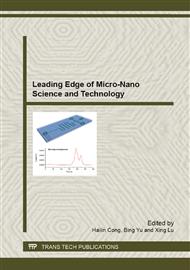[1]
H. Ermie, Nanotechnology: think before we leap, Environ Health Perspect. 112 (2004) 740 – 744.
Google Scholar
[2]
Q. Zhang, Y. Kusaka, X. Zhu, et al., Comparative toxicity of standard nickel and ultrafine nickel in lung after intratracheal instillation, J Occup Health. 45 (2003) 23- 30.
DOI: 10.1539/joh.45.23
Google Scholar
[3]
C. X. Mao, X. K. Tian, G. T. Yang, et al., DNA Damage of Hela Cells Induced by Nanosized MnO2 and Normal MnO2 Powder, Asian J Ecotox. 2 (2007) 190-194.
Google Scholar
[4]
L. Xiao, C. Fu, S. S. Liang, et al., Cytotoxicity Effects of Nano-SiO2 and Normal SiO2 Particles on Hela Cells, Asian J Ecotox. 2 (2007) 435-439.
Google Scholar
[5]
C. W. Lam, J. T. James, R. McCluskey, et al., Pulmonary toxicity of single - wall carbon nanotubes in mice 7 and 90 days after intratracheal instillation, Toxicol Sci. 77 (2004) 126- 134.
DOI: 10.1093/toxsci/kfg243
Google Scholar
[6]
W. S. Lin, Y. W. Huang, X. D. Zhou, et al., In vitro toxicity of silica nanoparticles in human lung cancer cells, Toxicol Appl Pharmacol. 217 (2006) 252- 259.
Google Scholar
[7]
Jr M. Bruchez, M. Moronne, P. Gin, et al., Semiconductor nanocrystals as fluorescent biological labels, Science. 281 (1998) 2013- (2016).
DOI: 10.1126/science.281.5385.2013
Google Scholar
[8]
H. B. Jones, D. A. Garside, R. Liu, et al., The influence of phthalate esters on Leydig cell structure and function in vitro and in vivo. Exp Mol Pathol, 58 (2005) l79- l93.
Google Scholar
[9]
A. A. Shvedova, E. R. Kisin, R. Mercer, et al., Unusual inflammatory and fibrogenic pulmonary responses to single- walled carbon nanotubes in mice, Am J Physiol Lung Cell Mol Physiol. 289 (2005) 698- 708.
Google Scholar
[10]
E. Oberdorster, Manufactured nanomaterials (fullerenes, C60) induce oxidative stress in the brain of juvenile largemouth bass, Environ Health Perspect. 112 (2004) 1058- 1062.
DOI: 10.1289/ehp.7021
Google Scholar
[11]
Z. Q. Lin, Z. G. Xi, F. H. Chao, et al., Study on the Oxidative Injury of the Vascular Endothelial Cell Affected by SWCNT, Asian J Ecotox. 1 (2006) 362-369.
Google Scholar
[12]
Q. Li, M. Tang, M. Ma, et al., The oxidative injury effect of hematite nanoparticles on mice, J Toxicol. 20 (2006) 380-382.
Google Scholar
[13]
H. M. Kipen, D. L. Laskin, Smaller is not always better: nanotechnology yields nanotoxicology, Am J Physiol Lung Cell Mol Physiol. 289 (2005) 696- 697.
DOI: 10.1152/ajplung.00277.2005
Google Scholar
[14]
H. Yang, D. F. Yang, H. S. Zhang, et al., Study on Cytotoxicity of Four Typical Nanomaterials in Mouse Embryo Fibroblasts, Asian J Ecotox. 2 (2007) 427-434.
Google Scholar
[15]
A. Nel, T. Xia, L. Mädler, et al., Toxic potential of materials at the nanolevel, Science. 311 (2006) 622- 627.
DOI: 10.1126/science.1114397
Google Scholar
[16]
I Papageorgiou, C. Brown, R. Schins, The effect of nano- and micron-sized particles of cobalt chromium alloy on human fibroblasts in vitro, Biomaterials. 28 (2007) 2946-2958.
DOI: 10.1016/j.biomaterials.2007.02.034
Google Scholar
[17]
A. M. Derfus, W. C. W. Chan, S. N. Bhatia, Probing the cytotoxicity of semiconductor quantum dots, Nano Lett. 4 (2004) 11-18.
DOI: 10.1021/nl0347334
Google Scholar
[18]
A. Shiohara, A. Hoshino, K. Hanaki, et al., On the cyto-toxity caused by quantum dots, Microbiol Immunol. 48 (2004) 669-675.
DOI: 10.1111/j.1348-0421.2004.tb03478.x
Google Scholar
[19]
J. M. Tsay, X. Michalet, New light on quantum dot cytotoxicity, Chem Biol. 12 (2005) 1159- 1161.
DOI: 10.1016/j.chembiol.2005.11.002
Google Scholar


